Mission: Impact podcast & blog
Build a better world without becoming a martyr to your nonprofit cause
Listen on:
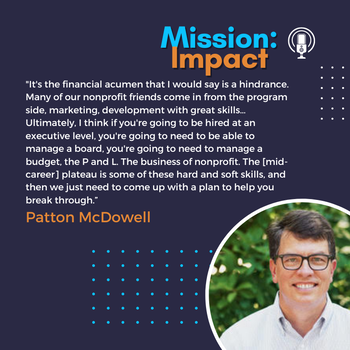 In episode 92 of Mission: Impact, Carol Hamilton and Patton McDowell explore the multi-generational nonprofit workforce, discussing the unique hurdles and opportunities that come with each stage of a non-profit career—from emerging leaders grappling with gaining practical experience to mid-career professionals encountering a plateau, and up to executive directors feeling isolated at the top. They underscore the importance of adaptability, continuous learning, and the benefits of strategic personal planning. Show highlights: Generational Workforce Challenges - [00:07:00] Discussion on the challenges faced by different generations in the nonprofit sector. Opportunity and Experience for Emerging Leaders - [00:08:05] Patton talks about the emerging leader generation facing the issue of opportunity and joy market entry difficulties Mid-Career Plateau - [00:19:25] Patton introduces the idea of a "mid-career plateau" and how to overcome it. Non-Traditional Career Paths - [00:22:00] Carol discusses lateral moves and specialization as alternatives to traditional progression. Executive Leadership Loneliness - [00:24:22] Patton discusses the isolation felt by those in executive leadership roles. Co-Executive Director Model - [00:29:00] Carol asks Patton about shared leadership roles and his views on them. Predictable Turnover - [00:33:00] Carol reflects on predictable turnover and proactive recruitment approaches. Organizational Exchanges - [00:39:10] Patton and Carol discuss the benefits of organizational exchanges and site visits. Personal Retreat for Leaders - [00:42:20] Patton recommends nonprofit leaders take personal retreats for strategic planning and Carol speaks on her own practice of personal strategic planning. Guest Bio:
Patton is the Founder of PMA Nonprofit Leadership, a coaching and consulting firm specializing in leadership development, fundraising, and strategic planning for nonprofits. He led fundraising efforts at two universities after starting his career at Special Olympics International. He's a Master Trainer for AFP Global, hosts the podcast Your Path to Nonprofit Leadership, and authored a best-selling book of the same name. He holds a bachelor's degree from UNC Chapel Hill, an MBA from Queens University of Charlotte, and a Doctorate from the University of Southern California. Patton currently serves as an Executive in Residence at the Jeb E. Brooks School of Public Policy at Cornell University. Important Links and Resources: Patton McDowell - https://www.linkedin.com/in/pattonmcdowell/ PMA Nonprofit https://www.pmanonprofit.com/ Charlie Gilkey - https://www.productiveflourishing.com/ Click "Read More" for a transcript of the interview. 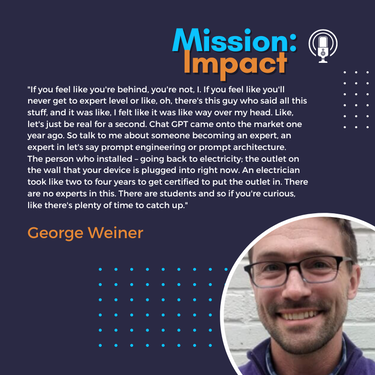 In episode 91 of Mission: Impact, Carol Hamilton and George Weiner discuss the intersection of artificial intelligence (AI) and the nonprofit sector. They delve into the significance of AI in the sector, emphasizing the need for strategic adoption and policy development. The conversation then shifts to the integration of AI into everyday tools They cover practical applications of AI and discuss crafting AI policies as well as the potential for AI to enhance nonprofit operations, particularly in grant writing and reporting. Episode highlights: [00:06:00] AI Adoption and Policy in Nonprofits [00:08:00] Hype Cycle of AI: [00:11:00] - AI in Everyday Life: [00:13:00] - AI for Nonprofit Content Creation [00:15:00] Crafting Nonprofit AI Policies and Guidelines [00:16:00] - Integrating AI in Nonprofits: [00:20:00] - Avoiding Overextension with AI: [00:24:00] - Practical AI Tools for Nonprofits: [00:27:00] Time Saving vs. Time Reallocation with AI [00:29:00] AI in Grant Writing: Guest Bio:
George Weiner is the Chief Whaler, WholeWhale.com. He co-founded CTOs For Good, PowerPoetry.org. He is a Dad, and a nonprofit geek. Important Links and Resources: WholeWhale.com George Weiner Cause Writer AI https://causewriter.ai/ The Smart Nonprofit by Beth Kanter and Allison Fine Click "Read More" for Transcript 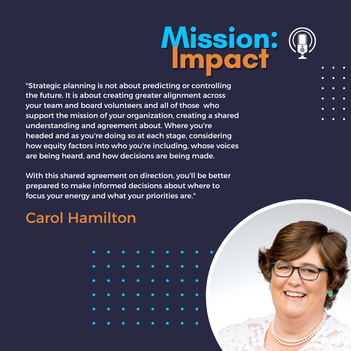 In episode 90 of Mission: Impact, Carol Hamilton goes solo and talks about:
Strategic planning:
Kick Off
Keeping the Plan Fresh
Important Links and Resources: Common Mistakes Organizations Make in Strategic planning: https://www.gracesocialsector.com/store/p13/strategic_plan_mistakes.html Be in touch ✉️ Subscribe to Carol’s newsletter at Grace Social Sector Consulting 💻 Give us feedback on the show 🌟 Like what you heard? Please help share the podcast by leaving a rating & review. 😀 Connect with Carol Hamilton ➡️ LinkedIn 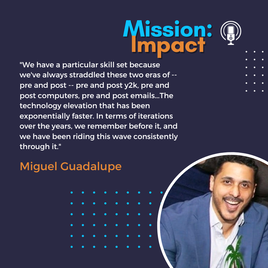 In episode 89 of Mission: Impact, Carol Hamilton and Miguel Guadalupe discuss issues of generational engagement in leadership, highlighting the frequent oversight of Generation X and stressing the unique adaptability and valuable perspective that this generation brings to the table. Miguel emphasizes the necessity for Generation X to advocate for recognition in leadership roles, reflecting on a LinkedIn post that sparked a broader conversation about the career stagnation felt by many in his generation. Episode highlights: Don’t Forget GenX: underrepresentation and unique contributions of Generation X in leadership and decision-making processes. Adapting to change: how Generation X's experience with the evolution of technology equips and other big changes over their career equips them with adaptability, a valuable skill set for leadership. Perpetual Utility player: Many of the Gen Xers who commented on Miguel’s LinkedIn post shared the feeling of being overlooked in their professional lives. Visibility and Advocacy: Miguel suggests that Generation X should take a lesson from Millenials and Gen Z and take a more assertive stance in advocating for their visibility and leadership opportunities. Guest Bio:
Miguel Guadalupe is Vice President of Donor and Community Relations at The Bowery Residents' Committee, or BRC in NYC. BRC helps over 10,000 individuals a year suffering from homelessness, mental illness, and addiction with the dignity and compassion they deserve. Miguel manages donor engagement, fundraising, and event planning, as well on service as BRC liaison to local elected officials, community organizations and businesses wherever a BRC program is located. He is also Vice Chair of the National Puerto Rican Day Parade, and helps to produce America's largest cultural celebration, in NYC, while helping to raise and distribute over $200K annually to students attending higher education. Important Links and Resources: Miguel’s viral LinkedIn post: https://www.linkedin.com/feed/update/urn:li:activity:7036817928465350656?updateEntityUrn=urn%3Ali%3Afs_feedUpdate%3A%28V2%2Curn%3Ali%3Aactivity%3A7036817928465350656%29 Miguel Guadalupe on LinkedIn: https://www.linkedin.com/in/miguelguadalupe/ The Bowery Residents' Committee https://www.brc.org/ Click "Read More" for Transcript 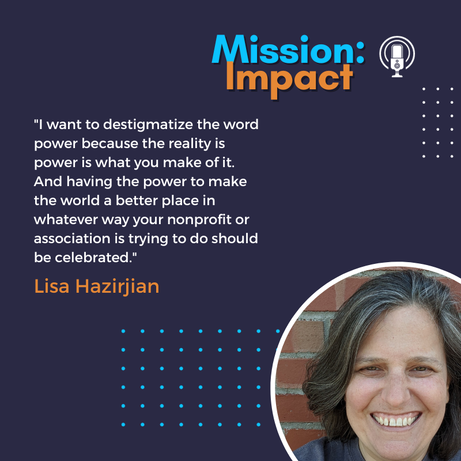 In episode 88, Carol Hamilton interviews Lisa Hazirjian, a historian turned advocate, as they delve into Lisa’s unexpected journey from academia to the forefront of nonprofit advocacy. Through a candid recount of personal challenges and professional transitions, Lisa shares her story, motivations, and the lessons she’s learned along the way. Some of the conversation’s highlights: Motivation for Advocacy: Personal emotions during times of loss and the desire to effect change in public policy were Lisa’s primary motivators to engage in advocacy work. Nonprofit Misconceptions: Lisa corrects the common misconception that nonprofits cannot engage in policy advocacy, stressing that they can and should, as they often hold valuable expertise that can inform policymaking.
Strategic Advocacy: Despite political power dynamics, Lisa argues that effective advocacy is less about which party is in power and more about the ability to influence decision-makers through strategic engagement and communication. Building Relationships: The importance of building relationships before needing to make an ask is highlighted, with suggestions to conduct surveys and use supporters as effective messengers to lawmakers. Volunteer Engagement: Discussion of a “ladder of engagement” approach to progressively involve volunteers in advocacy work, starting with simple actions and building up to higher responsibilities. Training and Responsibility: Emphasizing the need to train volunteers not just for tasks but also for understanding the bigger picture, the narrative includes a personal story demonstrating this practice. Small Wins and Community: Acknowledging small victories and the value of creating a sense of community among advocates is presented as crucial for maintaining motivation and momentum in long-term policy campaigns. For the transcript and more information click here: |
Archives
April 2024

Grace Social Sector Consulting, LLC, owns the copyright in and to all content in and transcripts of the Mission: Impact podcast, as well as the Mission: Impact blog with all rights reserved, including right of publicity.
|
Telephone301-857-9335
|
info[at]gracesocialsector.com
|
Grace Social Sector Consulting, LLC, owns the copyright in and to all content in, including transcripts and audio of the Mission: Impact podcast and all content on this website, with all rights reserved, including right of publicity.
|